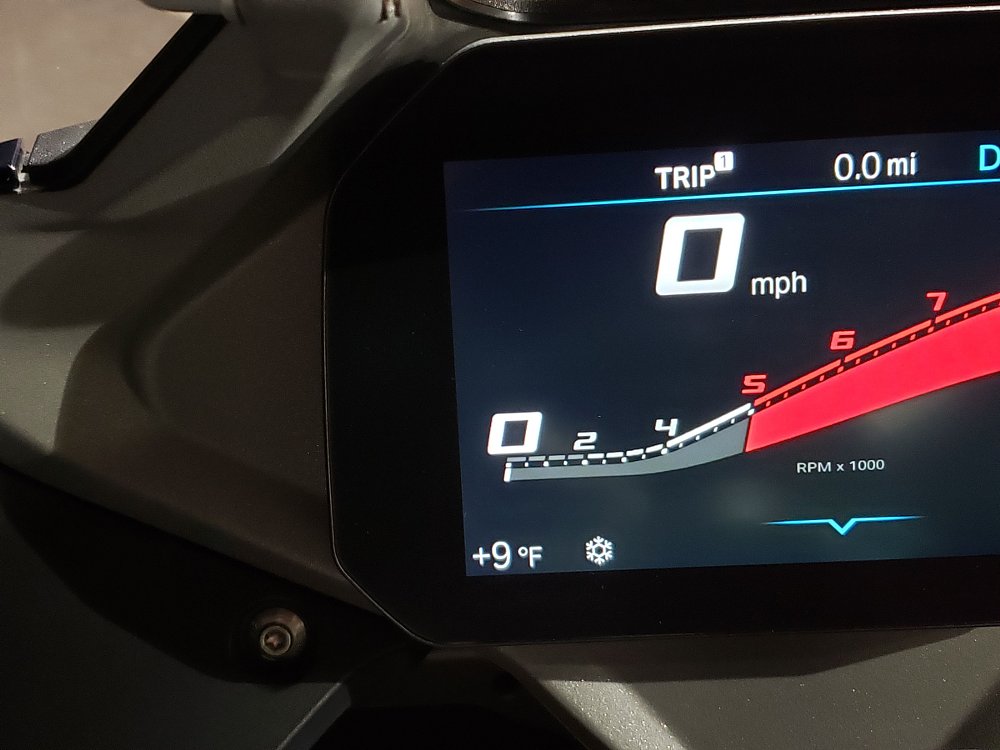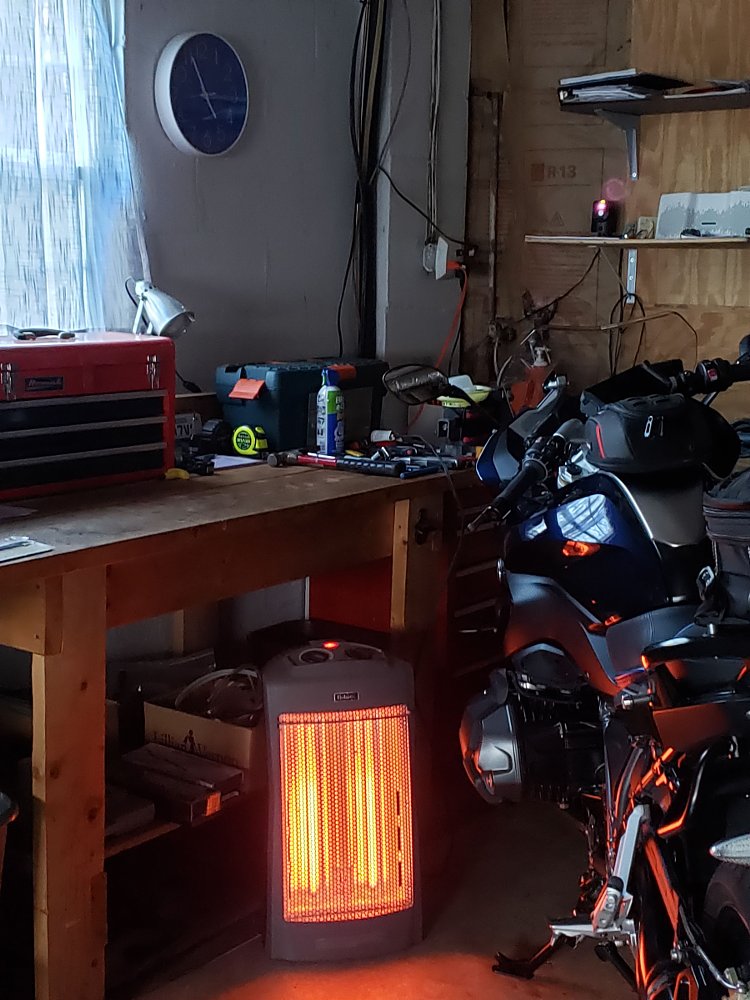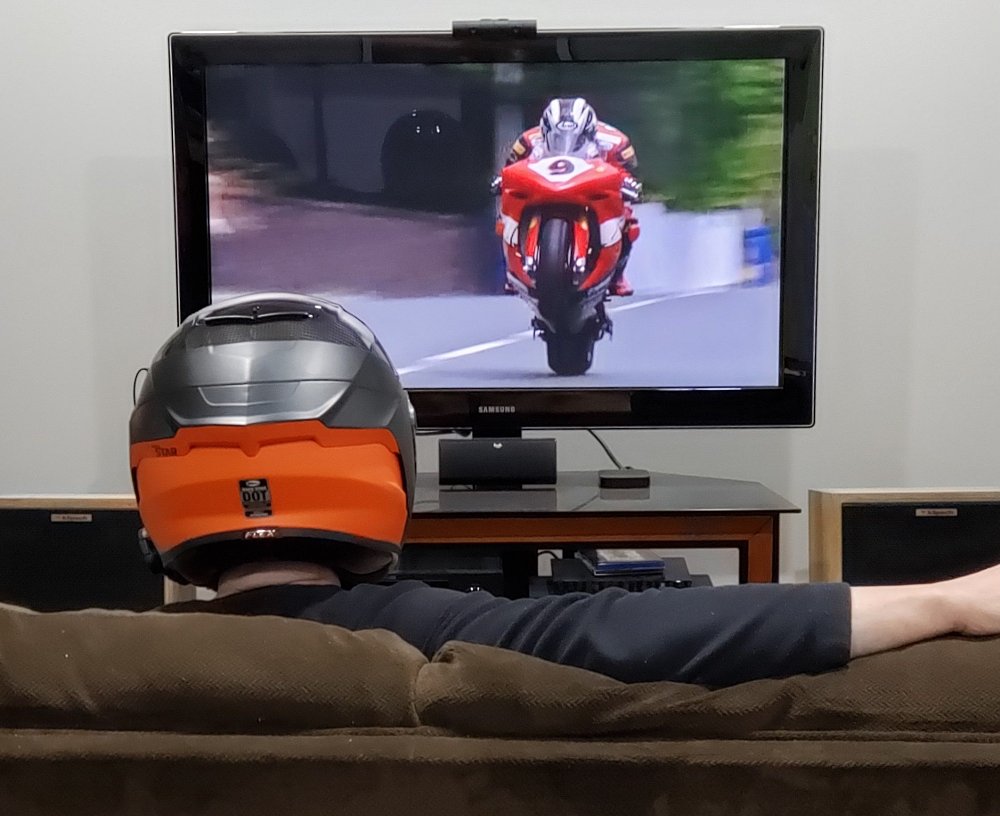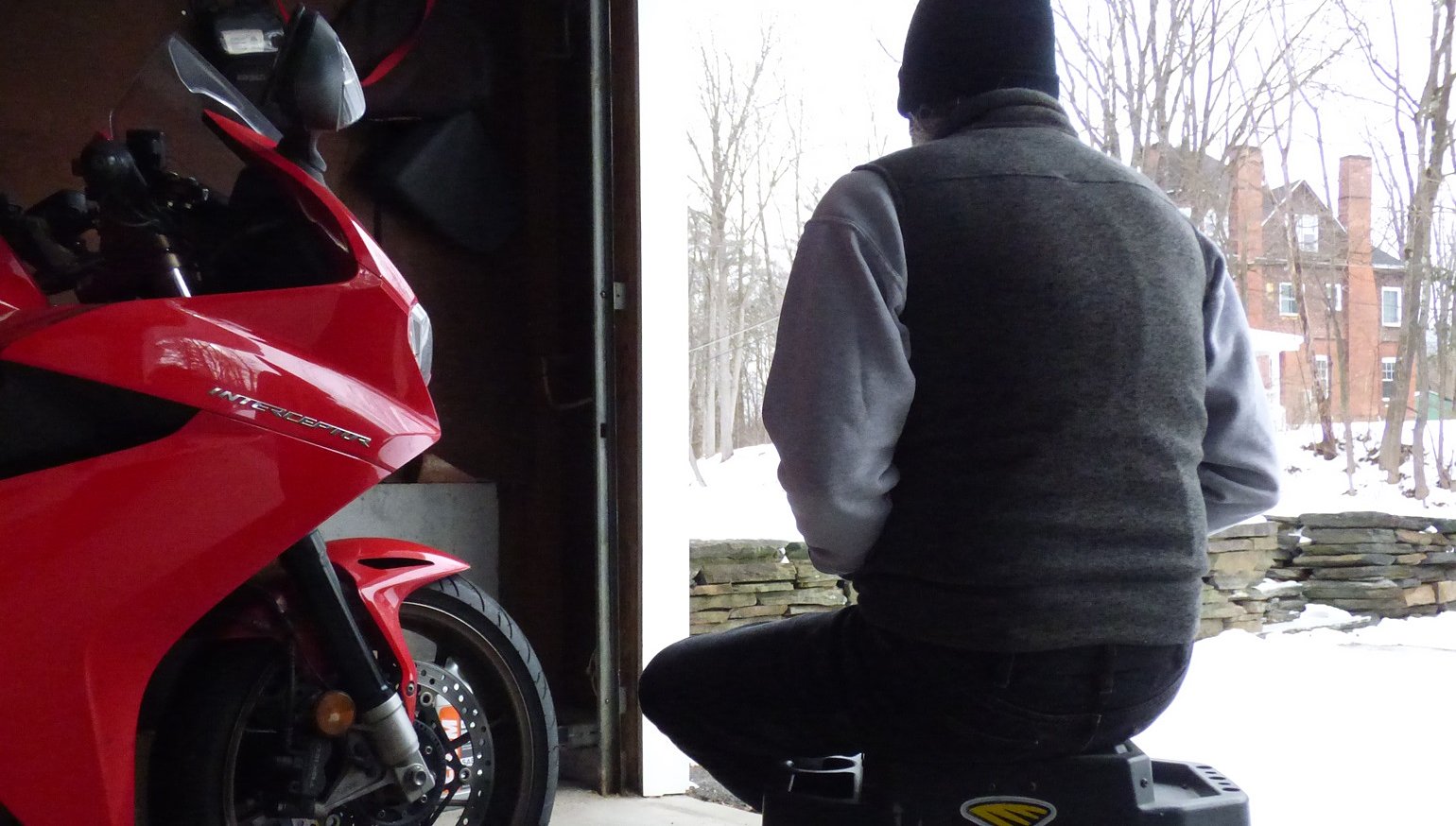As winter's dreary gray-brown palette dominates the landscape outside my garage window, I take comfort in the warm orange glow of the space heater angled between my bike and workbench. Temps where I live in eastern Tennessee can get bitter cold (see dash thermometer), but highs typically hover around 40 degrees in January and February, often with drizzling rain. Like now. I'll ride when it's 40 and I'll ride when it's rainy, but not both at once.
So, depending on when my free time coincides with relatively decent weather, I might go weeks between recreational two-wheeled outings this time of year. I realize motorcyclists living further north must endure much lengthier stretches of deprivation. My sympathies!
No matter how bad local weather gets, I can always catch a few warmish days of 50-degree sunshine scattered amidst the cold and wet, so I don't have to winterize my bikes. Nevertheless, I do have to "winterize myself," finding ways to cope with this dramatic reduction in riding frequency. Regardless of climactic issues, virtually every motorcyclist must contend with the occasional riding hiatus, and we need to keep our motorcycling selves charged, just as we protect our batteries from the consequences of disuse while the bikes they inhabit sit inert.
Editor's note: Dr. Barnes is a clinical psychologist in private practice who's ridden for half a century, written about motorcycling life for over three decades, and busted the myth that you'll never see a bike in a psychotherapist's parking lot.
Here are some ways we can winterize ourselves in these long, dark days.

Garage time
Garage time is a solution cherished by those of us who love spinning wrenches. Winter offers a great opportunity to install aftermarket parts, perform maintenance and repairs, or simply clean, polish, and adjust every little bit on our bikes to absolute perfection. Without the pressure of an imminent ride, these tasks can be done slowly with exacting care, allowing us to savor the process and eschew compromise.

Planning future rides
The fun of riding isn't confined to the time we spend with wheels turning. When we plan an adventure (even a tiny one) many weeks in the future, we enhance the entire interim. Collecting gear, prepping our bikes, discussing routes with riding buddies, and imagining the upcoming event all extend its pleasures all the way back to the present. Of course, good times also enrich subsequent weeks, months, and years with treasured memories. We enjoy our rides long before and long after we actually take them.
Signing up for a track day or riding school, laying out a group tour, or just scouring maps and enthusiast media for intriguing nearby destinations will plant seeds that bear fruit immediately, despite the fact those events won't occur until months later. Getting together with others who will be involved boosts the anticipation factor exponentially.
Learning
While having a special goal in mind usually improves our focus and motivation, we can also bolster our mental and physical readiness for riding in general during forced downtime. Sitting in front of the fireplace with a warming beverage, reading books and articles or watching videos devoted to skill development will keep our awareness of technique fresh and sharp. Such study reminds us of areas we need to work on and expands our knowledge of details previously unexamined, whether in terms of how to perform certain operations or how and why various actions have their desired (or unwanted) effects. Science! Sure, extensive physical practice required to transform these abstract concepts into concrete competencies. But we can't practice skills we don't know exist, and can't distinguish good execution from bad if we don’t have an accurate conceptual framework with which to begin.

Lots of learning can also occur off the bike with the use of visualization. Try going through the motions with eyes closed as you imagine a favorite corner, coordinating your clutching, braking, shifting, and throttle movements, synchronizing footpeg weighting and body positioning with your countersteering. If it feels silly, remember the very best riders in the world — professional racers — do exactly this type of exercise, rehearsing for countless hours. Still, there's obviously no substitute for practice in real-life situations, so commit to putting all your off-season study to good use as soon as you head out on that first spring ride. Warming up with selected parking lot drills can save rusty riders much grief when their excitement would otherwise outpace their physical abilities. Better yet, on mid-winter days when it's too cold to ride at highway speeds, set up cones on empty pavement to master low-speed maneuvering. There's no wind chill at a walking pace, and such practice can be surprisingly strenuous. You might even work up a sweat! Invite your friends to join in the winter games so everyone benefits.
Maintenance is not just for motorcycles
We tend to get fatter, stiffer and weaker during the winter months, retreating deeply into our caves to wait out the cold passively, hibernation-style. Without regular and substantive fitness-related activity, we'll climb back into our saddles in the spring in considerably worse shape than the last time we rode, increasing the dangerous discrepancy between our pent-up enthusiasm and lagging physical condition. Intellectually, we remember being able to do this or that, but our muscle memory has forgotten things, our bodies feel sluggish and our movements have become awkward.
How great would it be to hop on our bikes in better shape than when we last dismounted? Alongside visualization practice, strength training, stretching, and aerobic conditioning pay off big on a motorcycle, allowing us to ride longer, more safely, and with less effort. Healthy sleeping, eating, and hydration habits also contribute here. We can cultivate self-discipline more readily if we consciously and purposefully connect it to our riding enjoyment; establishing diet and exercise routines is easier with winter restricting our leisure options. Waiting until spring ensures we won't be fit when we really need to be.
Riding makes global demands on our minds and bodies. For example, in addition to the specific skills unique to operating a motorcycle, we need good overall balance and flexibility. If I can't detect and reflexively counteract my bike's seduction by gravity at low speeds, all those hundreds of pounds will fall to earth faster than I can catch them. And if I'm not strong enough (or don’t know an effective method) to pick up a fallen motorcycle, I'll be stranded if I so much as drop mine gently at a standstill. If my neck lacks range of motion, my pre-lane-change head checks will be compromised, leaving me more vulnerable to collisions. Stiff hips and knees will make the riding position difficult to maintain, or even distractingly painful, and a limber body is less apt to sustain severe injury in a fall. Mentally, if I have no way to efficiently calm myself and refocus my attention after a distressing event, I'll be unable to continue my journey with a clear head following the inevitable frightening or infuriating close call.
We can make gains on all these fronts with a single mind-body integration tool: yoga for motorcyclists (yep, that's a thing — Google it).
Using strategically designed postures, stretches, bodyweight resistance, and breathing techniques, such practices improve balance, flexibility, strength, and emotional self-regulation. There's no shortage of online yoga classes, but (as with weightlifting) in-person instruction is usually essential to developing correct form, as there can be huge differences between the position we think we're in and the one we've actually achieved. Knowing where our bodies truly are in space (proprioception) is another plus on our bikes, as is learning to graciously accept our limits and content ourselves with their incremental expansion. It's important to start at an appropriate level and not get ahead of ourselves in any training endeavor.
Whether or not we try yoga, staying physically active during the winter not only burns calories and keeps our bellies off the tank come spring, it also helps maintain mobility and stamina, and can improve sleep and mood (especially when combined with morning sunlight exposure). Better health equals better riding. Why not invest in the "upper half of the motorcycle" while the lower half is in storage?

Entertainment for motorcyclists in forced hibernation
Motorcycle-oriented entertainment provides vicarious thrills and discoveries. Watching races, riding travelogues, and historical documentaries helps pass the time as winter, or any other riding interruption, drags on. Distraction is a potent anesthetic, and a perfectly legitimate means of easing our pain while we wait for pleasant weather — all the better if it immerses us psychologically in what we’re missing. When escapism fails, we can explicitly remind ourselves this deprivation is time-limited and start a countdown calendar to the typical date of spring’s arrival where we live.
Finally, if you’re like me, you may also find some satisfaction just sitting in a warm garage, silently admiring the aesthetics and engineering of a beloved machine you can do nothing else with at the moment. My space heater isn't the only thing glowing on this dim winter afternoon.









